常见九种英语时态
- 格式:ppt
- 大小:379.50 KB
- 文档页数:32
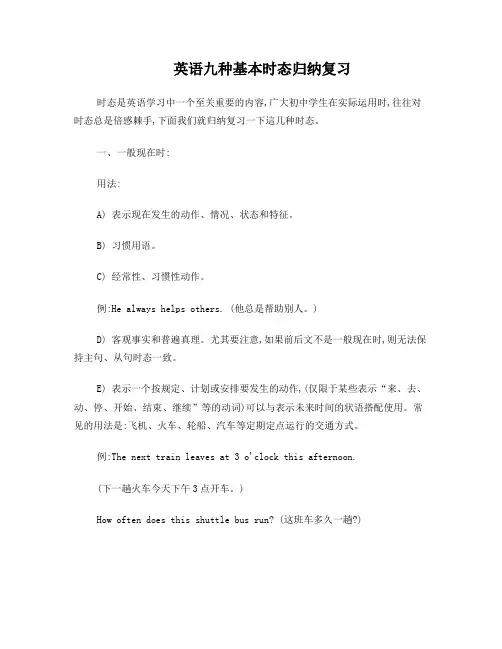
英语九种基本时态归纳复习时态是英语学习中一个至关重要的内容,广大初中学生在实际运用时,往往对时态总是倍感棘手,下面我们就归纳复习一下這几种时态。
一、一般现在时:用法:A) 表示现在发生的动作、情况、状态和特征。
B) 习惯用语。
C) 经常性、习惯性动作。
例:He always helps others. (他总是帮助别人。
)D) 客观事实和普遍真理。
尤其要注意,如果前后文不是一般现在时,则无法保持主句、从句时态一致。
E) 表示一个按规定、计划或安排要发生的动作,(仅限于某些表示“来、去、动、停、开始、结束、继续”等的动词)可以与表示未来时间的状语搭配使用。
常见的用法是:飞机、火车、轮船、汽车等定期定点运行的交通方式。
例:The next train leaves at 3 o'clock this afternoon.(下一趟火车今天下午3点开车。
)How often does this shuttle bus run? (这班车多久一趟?)F) 在时间和条件状语从句里经常用一般现在(有时也用现在完成时)表示将来事情。
例:When you have finished the report, I will have waited for about 3 hours.(等你完成这份报告的时候,我就已经等了将近3个小时了。
)经常、反复发生的动作或行为及现在的某种状况。
时间状语:always, usually, often, sometimes, every week (day, year, month…), once a week, on Sundays, etc.基本结构:①be动词;②行为动词否定形式:①am/is/are+not;②此时态的谓语动词若为行为动词,则在其前加don't,如主语为第三人称单数,则用doesn't,同时还原行为动词。
一般疑问句:①把be动词放于句首;②用助动词do提问,如主语为第三人称单数,则用does,同时,还原行为动词。
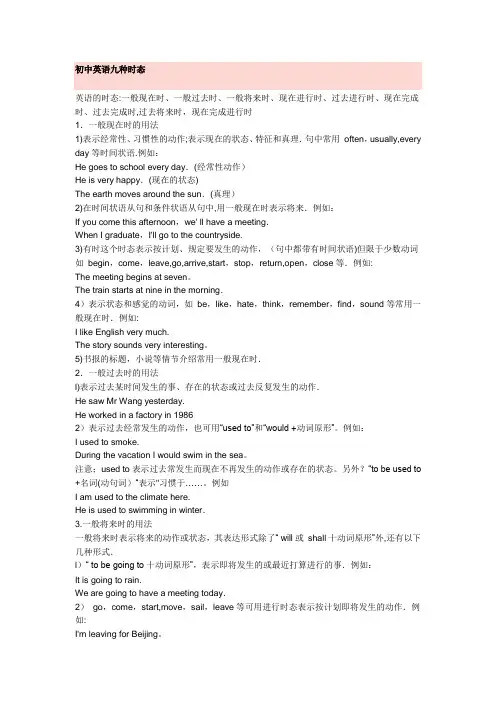
初中英语九种时态英语的时态:一般现在时、一般过去时、一般将来时、现在进行时、过去进行时、现在完成时、过去完成时,过去将来时,现在完成进行时1.一般现在时的用法1)表示经常性、习惯性的动作;表示现在的状态、特征和真理.句中常用often,usually,every day等时间状语.例如:He goes to school every day.(经常性动作)He is very happy.(现在的状态)The earth moves around the sun.(真理)2)在时间状语从句和条件状语从句中,用一般现在时表示将来.例如:If you come this afternoon,we' ll have a meeting.When I graduate,I'll go to the countryside.3)有时这个时态表示按计划、规定要发生的动作,(句中都带有时间状语)但限于少数动词如begin,come,leave,go,arrive,start,stop,return,open,close等.例如:The meeting begins at seven。
The train starts at nine in the morning.4)表示状态和感觉的动词,如be,like,hate,think,remember,find,sound等常用一般现在时.例如:I like English very much.The story sounds very interesting。
5)书报的标题,小说等情节介绍常用一般现在时.2.一般过去时的用法l)表示过去某时间发生的事、存在的状态或过去反复发生的动作.He saw Mr Wang yesterday.He worked in a factory in 19862)表示过去经常发生的动作,也可用“used to”和“would +动词原形”。
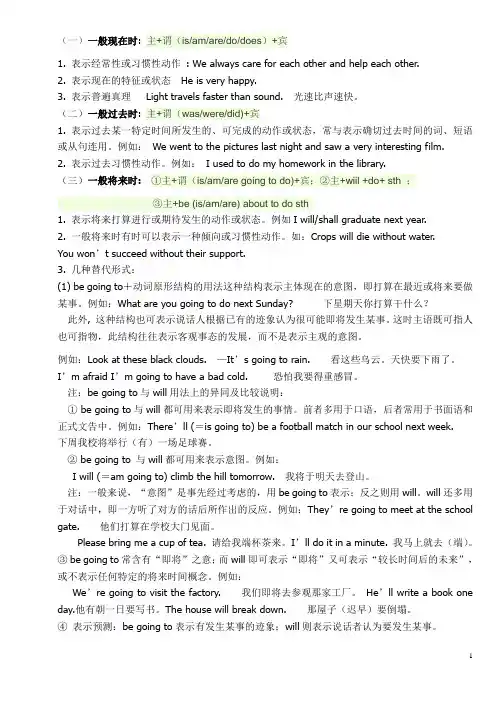
(一)一般现在时: 主+谓(is/am/are/do/does)+宾1. 表示经常性或习惯性动作: We always care for each other and help each other.2. 表示现在的特征或状态He is very happy.3. 表示普遍真理Light travels faster than sound. 光速比声速快。
(二)一般过去时: 主+谓(was/were/did)+宾1. 表示过去某一特定时间所发生的、可完成的动作或状态,常与表示确切过去时间的词、短语或从句连用。
例如:We went to the pictures last night and saw a very interesting film.2. 表示过去习惯性动作。
例如:I used to do my homework in the library.(三)一般将来时:①主+谓(is/am/are going to do)+宾;②主+wiil +do+ sth ;③主+be (is/am/are) about to do sth1. 表示将来打算进行或期待发生的动作或状态。
例如I will/shall graduate next year.2. 一般将来时有时可以表示一种倾向或习惯性动作。
如:Crops will die without water.You won’t succeed without their support.3. 几种替代形式:(1) be going to+动词原形结构的用法这种结构表示主体现在的意图,即打算在最近或将来要做某事。
例如:What are you going to do next Sunday? 下星期天你打算干什么?此外, 这种结构也可表示说话人根据已有的迹象认为很可能即将发生某事。
这时主语既可指人也可指物,此结构往往表示客观事态的发展,而不是表示主观的意图。
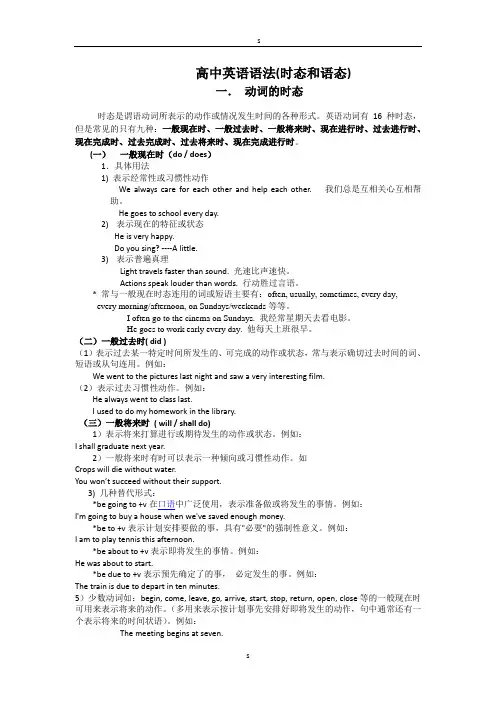
高中英语语法(时态和语态)一.动词的时态时态是谓语动词所表示的动作或情况发生时间的各种形式。
英语动词有16种时态,但是常见的只有九种:一般现在时、一般过去时、一般将来时、现在进行时、过去进行时、现在完成时、过去完成时、过去将来时、现在完成进行时。
(一)一般现在时(do / does)1.具体用法1) 表示经常性或习惯性动作We always care for each other and help each other. 我们总是互相关心互相帮助。
He goes to school every day.2)表示现在的特征或状态He is very happy.Do you sing? ----A little.3)表示普遍真理Light travels faster than sound. 光速比声速快。
Actions speak louder than words. 行动胜过言语。
* 常与一般现在时态连用的词或短语主要有:often, usually, sometimes, every day,every morning/afternoon, on Sundays/weekends等等。
I often go to the cinema on Sundays. 我经常星期天去看电影。
He goes to work early every day. 他每天上班很早。
(二)一般过去时( did )(1)表示过去某一特定时间所发生的、可完成的动作或状态,常与表示确切过去时间的词、短语或从句连用。
例如:We went to the pictures last night and saw a very interesting film.(2)表示过去习惯性动作。
例如:He always went to class last.I used to do my homework in the library.(三)一般将来时( will / shall do)1)表示将来打算进行或期待发生的动作或状态。
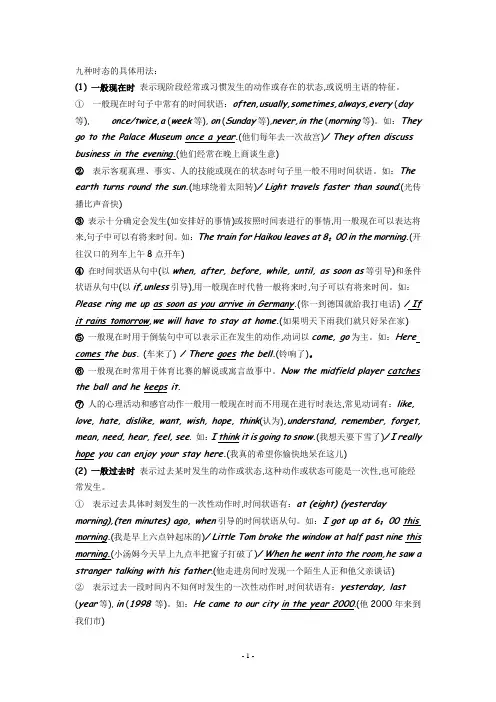
九种时态的具体用法:(1) 一般现在时表示现阶段经常或习惯发生的动作或存在的状态,或说明主语的特征。
①一般现在时句子中常有的时间状语:often,usually,sometimes,always,every (day等), once/twice,a (week等), on (Sunday等),never,in the (morning等)。
如:They go to the Palace Museum once a year.(他们每年去一次故宫)/ They often discuss business in the evening.(他们经常在晚上商谈生意)②表示客观真理、事实、人的技能或现在的状态时句子里一般不用时间状语。
如:The earth turns round the sun.(地球绕着太阳转)/ Light travels faster than sound.(光传播比声音快)③表示十分确定会发生(如安排好的事情)或按照时间表进行的事情,用一般现在可以表达将来,句子中可以有将来时间。
如:The train for Haikou leaves at 8:00 in the morning.(开往汉口的列车上午8点开车)④在时间状语从句中(以when, after, before, while, until, as soon as等引导)和条件状语从句中(以if,unless引导),用一般现在时代替一般将来时,句子可以有将来时间。
如:Please ring me up as soon as you arrive in Germany.(你一到德国就给我打电话) / If it rains tomorrow,we will have to stay at home.(如果明天下雨我们就只好呆在家)⑤一般现在时用于倒装句中可以表示正在发生的动作,动词以come, go为主。
如:Here comes the bus. (车来了) / There goes the bell.(铃响了)。
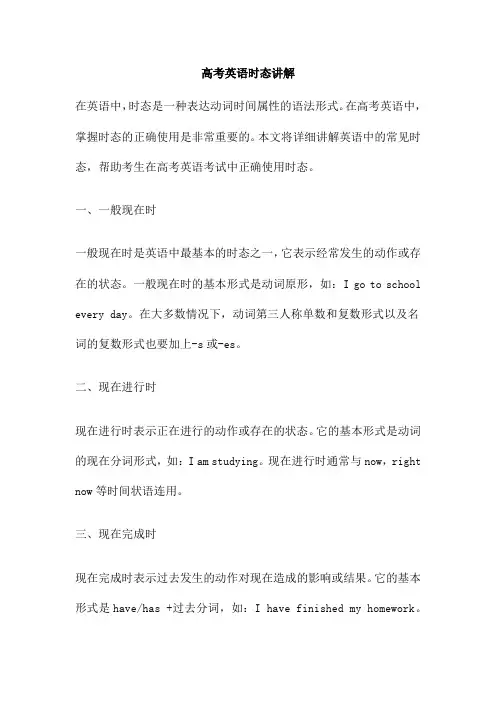
高考英语时态讲解在英语中,时态是一种表达动词时间属性的语法形式。
在高考英语中,掌握时态的正确使用是非常重要的。
本文将详细讲解英语中的常见时态,帮助考生在高考英语考试中正确使用时态。
一、一般现在时一般现在时是英语中最基本的时态之一,它表示经常发生的动作或存在的状态。
一般现在时的基本形式是动词原形,如:I go to school every day。
在大多数情况下,动词第三人称单数和复数形式以及名词的复数形式也要加上-s或-es。
二、现在进行时现在进行时表示正在进行的动作或存在的状态。
它的基本形式是动词的现在分词形式,如:I am studying。
现在进行时通常与now,right now等时间状语连用。
三、现在完成时现在完成时表示过去发生的动作对现在造成的影响或结果。
它的基本形式是have/has +过去分词,如:I have finished my homework。
现在完成时通常与already,yet等副词连用。
四、一般过去时一般过去时表示过去发生的动作或存在的状态。
它的基本形式是动词的过去式,如:I went to the park yesterday。
在大多数情况下,动词第三人称单数和复数形式以及名词的复数形式也要加上-ed或-d。
五、过去进行时过去进行时表示过去正在进行的动作或存在的状态。
它的基本形式是was/were +现在分词,如:I was studying at this time yesterday。
过去进行时通常与at this time yesterday等时间状语连用。
六、过去完成时过去完成时表示过去的过去发生的动作对过去造成的影响或结果。
它的基本形式是had +过去分词,如:I had finished my homework before dinner。
过去完成时通常与already,yet等副词连用。
七、一般将来时一般将来时表示将来要发生的动作或存在的状态。
它的基本形式是will +动词原形,如:I will go to school tomorrow。
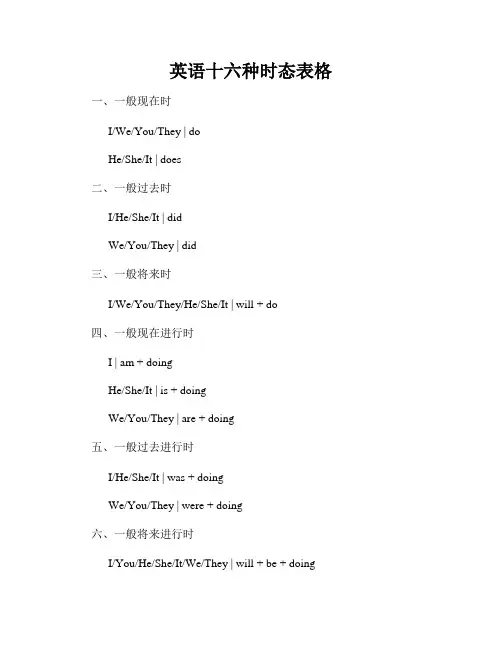
英语十六种时态表格一、一般现在时I/We/You/They | doHe/She/It | does二、一般过去时I/He/She/It | didWe/You/They | did三、一般将来时I/We/You/They/He/She/It | will + do四、一般现在进行时I | am + doingHe/She/It | is + doingWe/You/They | are + doing五、一般过去进行时I/He/She/It | was + doingWe/You/They | were + doing六、一般将来进行时I/You/He/She/It/We/They | will + be + doing七、一般现在完成时I/You/We/They/He/She/It | have/has + done八、一般过去完成时I/You/We/They/He/She/It | had + done九、一般将来完成时I/You/We/They/He/She/It | will have + done十、现在完成进行时I/You/We/They/He/She/It | have/has been + doing 十一、过去完成进行时I/You/We/They/He/She/It | had been + doing十二、将来完成进行时I/You/We/They/He/She/It | will have been + doing 十三、现在完成时I/You/We/They/He/She/It | have/has + done十四、过去完成时I/You/We/They/He/She/It | had + done十五、将来完成时I/You/We/They/He/She/It | will have + done十六、过去将来时I/You/He/She/It/We/They | would + do以上是英语中的十六种时态及其对应的动词形式。
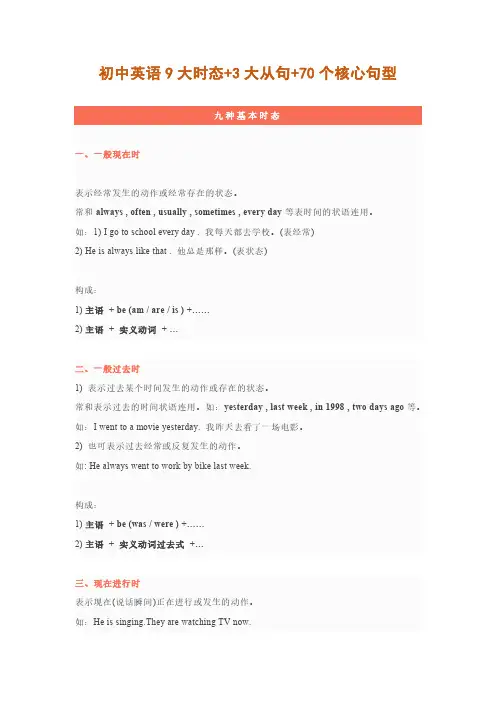
初中英语9大时态+3大从句+70个核心句型九种基本时态一、一般现在时表示经常发生的动作或经常存在的状态。
常和always , often , usually , sometimes , every day等表时间的状语连用。
如:1) I go to school every day . 我每天都去学校。
(表经常)2) He is always like that . 他总是那样。
(表状态)构成:1) 主语+ be (am / are / is ) +……2) 主语+ 实义动词+ …二、一般过去时1) 表示过去某个时间发生的动作或存在的状态。
常和表示过去的时间状语连用。
如:yesterday , last week , in 1998 , two days ago等。
如:I went to a movie yesterday. 我昨天去看了一场电影。
2) 也可表示过去经常或反复发生的动作。
如: He always went to work by bike last week.构成:1) 主语+ be (was / were ) +……2) 主语+ 实义动词过去式+…三、现在进行时表示现在(说话瞬间)正在进行或发生的动作。
如:He is singing.They are watching TV now.构成:主语+ 助动词be(am/are/is) + 动词-ing形式构成四、过去进行时表示过去某一时刻或某一段时间正在进行的动作。
这一特定的过去时间除了有上下文暗示外,一般用时间状语来表示。
如:1) ---What were you doing?---I was jumping.2) ---What was the boy doing when the UFO arrived?---He was sleeping.构成:主语+ 助动词be(was/were) + 动词-ing形式构成.五、一般将来时表示将来某个时间要发生的动作或存在的状态,也表示将来经常或反复发生的动作。
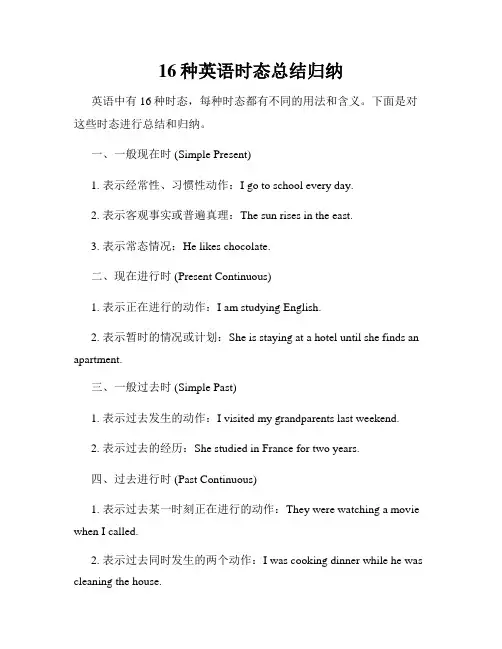
16种英语时态总结归纳英语中有16种时态,每种时态都有不同的用法和含义。
下面是对这些时态进行总结和归纳。
一、一般现在时 (Simple Present)1. 表示经常性、习惯性动作:I go to school every day.2. 表示客观事实或普遍真理:The sun rises in the east.3. 表示常态情况:He likes chocolate.二、现在进行时 (Present Continuous)1. 表示正在进行的动作:I am studying English.2. 表示暂时的情况或计划:She is staying at a hotel until she finds an apartment.三、一般过去时 (Simple Past)1. 表示过去发生的动作:I visited my grandparents last weekend.2. 表示过去的经历:She studied in France for two years.四、过去进行时 (Past Continuous)1. 表示过去某一时刻正在进行的动作:They were watching a movie when I called.2. 表示过去同时发生的两个动作:I was cooking dinner while he was cleaning the house.五、一般将来时 (Simple Future)1. 表示将要发生的动作:I will meet you at the park tomorrow.2. 表示决定或打算:We are going to have a party next weekend.六、将来进行时 (Future Continuous)1. 表示将来某一时刻正在进行的动作:They will be traveling to Europe this time next year.2. 表示持续性的动作:I will be working late tonight.七、现在完成时 (Present Perfect)1. 表示过去发生但与现在有关的动作:I have finished my homework.2. 表示经历或经验:He has traveled to many countries.八、过去完成时 (Past Perfect)1. 表示在过去某一时刻之前已经完成的动作:They had already left when I arrived.2. 表示顺序:She had read the book before watching the movie.九、将来完成时 (Future Perfect)1. 表示将来某一时刻之前完成的动作:I will have finished my project by tomorrow.2. 表示结果:They will have arrived by the time we get there.十、现在完成进行时 (Present Perfect Continuous)1. 表示从过去某一时刻开始一直持续到现在的动作:I have been studying for three hours.2. 表示强调动作的持续性:He has been working all day.十一、过去完成进行时 (Past Perfect Continuous)1. 表示过去某一时刻之前一直持续到过去的动作:She had been waiting for two hours when the bus finally arrived.2. 表示强调动作的持续性:They had been playing tennis all afternoon.十二、将来完成进行时 (Future Perfect Continuous)1. 表示将来某一时刻之前持续进行的动作:I will have been studying for five hours by the time the exam starts.2. 表示强调动作的持续性:They will have been working on the project for a month.十三、虚拟现在时 (Present Unreal)1. 表示与现在事实相反的假设:If I were rich, I would buy a mansion.2. 表示建议或要求:I suggest that he study more.十四、虚拟过去时 (Past Unreal)1. 表示与过去事实相反的假设:If I had studied harder, I would have passed the exam.2. 表示遗憾或后悔:I wish I had bought that dress.十五、虚拟将来时 (Future Unreal)1. 表示与将来事实相反的假设:If I won the lottery, I would travel the world.2. 表示不可能实现的愿望:I wish she would become a famous singer.十六、过去将来时 (Future in the Past)1. 表示过去某一时刻之后将要发生的动作:He said he would call me later.2. 表示过去的计划:I thought we were going to have dinner together.以上是对16种英语时态的总结归纳。
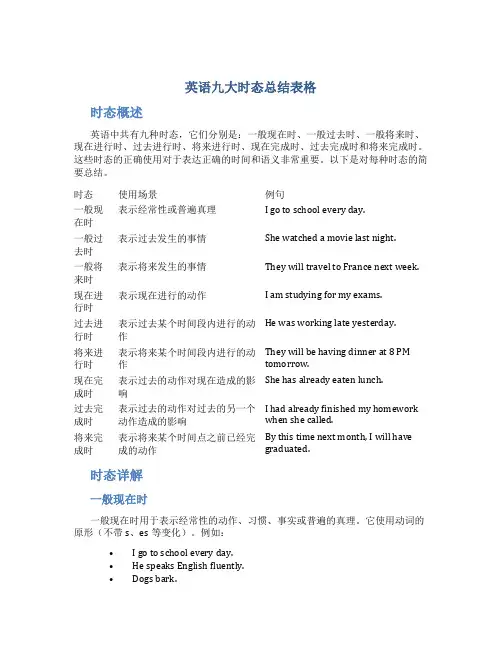
英语九大时态总结表格时态概述英语中共有九种时态,它们分别是:一般现在时、一般过去时、一般将来时、现在进行时、过去进行时、将来进行时、现在完成时、过去完成时和将来完成时。
这些时态的正确使用对于表达正确的时间和语义非常重要。
以下是对每种时态的简要总结。
时态使用场景例句一般现在时表示经常性或普遍真理I go to school every day.一般过去时表示过去发生的事情She watched a movie last night.一般将来时表示将来发生的事情They will travel to France next week.现在进行时表示现在进行的动作I am studying for my exams.过去进行时表示过去某个时间段内进行的动作He was working late yesterday.将来进行时表示将来某个时间段内进行的动作They will be having dinner at 8 PMtomorrow.现在完成时表示过去的动作对现在造成的影响She has already eaten lunch.过去完成时表示过去的动作对过去的另一个动作造成的影响I had already finished my homeworkwhen she called.将来完成时表示将来某个时间点之前已经完成的动作By this time next month, I will havegraduated.时态详解一般现在时一般现在时用于表示经常性的动作、习惯、事实或普遍的真理。
它使用动词的原形(不带s、es等变化)。
例如:•I go to school every day.•He speaks English fluently.•Dogs bark.一般过去时一般过去时用于表示过去发生的事情或状态。
它使用动词的过去式形式。
例如:•She watched a movie last night.•They lived in that house for five years.•I didn’t see him yesterday.一般将来时一般将来时用于表示将来要发生的事情。

(完整)高中九大时态讲解高中九大时态讲解1、一般现在时1.表示现在习惯或经常反复发生的动作。
常与always,usually,often,sometimes,every day (week, month)等连用。
He plays football twice a week.他每周踢两次足球。
I sometimes go to work on foot.我有时步行去上班。
2.表示现在的事实或状态。
It’s cold today.今天很冷。
You look tired now.你现在看起来很疲乏。
3.现在时刻的状态、能力、性格、个性。
I don't want so much.Ann Wang writes good English but does not speak well.4.表示格言或警句中。
Pride goes before a fall.骄者必败。
注意:此用法如果出现在宾语从句中,即使主句是曩昔时,从句谓语也要用一般现在时。
例:Columbus proved that the earth is round..5.表示客观事实或广泛其理。
It’s far from theearth to the sun.地球与太阳间的距离很远。
Five and three makes eight.五加三得八。
5.表示已预先安排或计划好将来确定会发生的动作。
但首要用于go, come, leave, start, return, arrive等瞬间动词。
The train from London arrives at 7:00.从伦敦来的火车7:00到站。
He leaves on business the day after tomorrow.他后天出差。
6.在时间、让步及条件状语从句中表示将来的动作。
I’ll call you as soon as I get there.我一到那里就打电话给你。
英语时态总结(完整),全全英语的时态是由动词的变化和时间状语来表达的。
英语中共有十六种时态,但常考或常用的只有九种。
要掌握英语的时态和语态,必须掌握好英语中的助动词(do。
be。
have)和时间状语这两个核心问题。
一般现在时主要用来表示人、事物的现在状况和特点,表示经常或惯性的动作。
句子中常有often。
always。
from timeto time等时间状语,也可表示客观规律和永恒真理等。
例如,He usually goes to work at 7 o’clock every morning.(他每天7点上班。
)现在进行时表示说话时或目前一段时间内正在进行的活动,也可表达感情色彩,加强语气。
与频率副词,如always,constantly,continually,XXX等连用表示说话人的某种感情色彩(赞叹、厌烦、埋怨等)。
例如,We are having English class.(我们正在上英语课。
)现在完成时表示动作发生在过去,完成在过去,但强调与现在情况仍有联系,其结果或影响仍存在。
例如,I have XXX (我已经完成了作业。
)其他时态包括现在完成进行时、过去一般时、过去进行时、过去完成时、过去完成进行时、将来一般时、将来进行时、将来完成时和将来完成进行时。
掌握这些时态对于学好英语非常重要。
They have been living in Beijing for five years now。
This tense is used to XXX up until now.He used to smoke a lot。
but he has quit now。
This tense is used to XXX true in the present.In August 2008.Beijing was hosting the 29th Olympic Games。
This tense is used to talk about an n that was in progress at a specific point in the past.By the time we arrived。
初中英语九种时态归纳复习英语时态分为16种:一般现在、一般过去、一般将来、过去将来时,以及这四者的进行时、完成时和完成进行时。
英语的时态(tense)是一种动词形式,不同的时态用以表示不同的时间与方式。
是表示行为、动作和状态在各种时间条件下的动词形式。
因此,当我们说时态结构的时候,指的是相应时态下的动词形式。
下面主要是对初中英语九种时态进行阐述一般现在时:概念:1)表经常的或习惯性的动作 e.g. I go to school at 7:30 every day .2) 表现在的状态e. g. He is thirteen . She is at home .3)表主语具备的性格和能力等e.g. We like P.E. . They know English.基本结构:肯定句:1是“be”动词:主语+am / is / are + …(I am , He is , You /They are…)(I am --- I’m you are---- you’re he is --- he’s she is -- she’s they are --- they’re )e. g. I’m Gina . He is my friend .2.行为动词:主语+动词原形+… e. g. I go to work very early every day .主语(第三人称单数)+动词的第三人称单数形式( S + v. + -s / -es ) e. g. He likes bananas .3.情态动词can + 动词原形e. g. I can speak a little French.否定句:1“是”动词:主语+am / is / are + not + …(I am not --- I’m not you are not --- you aren’t he is not --- he isn’t …)e.g. He is not a reporter . You are not a doctor .2.行为动词:主语+don’t (do not) +动词原形+… e.g. They don’t like broccoli .主语(三单)+ doesn’t (does not) + 动词原形+ … e.g. He doesn’t like ice cream .3.主语+can’t (can not ) + 动原 e. g. Bob can’t play chess.一般疑问句:1 “是”动词:Am / Is / Are +主语+ …回答:肯:Yes , 主+ am / is / are 否:No , 主+am /is / are +note.g. Am I right ? Yes ,you are . Is he at home ? No, he isn’t . Are you at work ? Yes , I am .2. 行为动词:Do +主语+动原+…?回答:Yes ,主+do. No , 主+don’t .e.g. Do you have a basketball ? Yes , I do . /No , I don’t .Does +主(三单)+动原+…?回答:Yes , 主+does . No , 主+ doesn’t .e.g. Does he like swimming ? Yes , he does ./ No , he doesn’t .3.Can + 主语+动词原形…?e . g. Can you dance ? Yes, I can ./ No. I can’t.特殊疑问句:1“是”动词,:特殊疑问词+am / is / are / +主语+…?e.g. Where are you ? I am at home .2行为动词:特殊疑问词+do / does + 主+动原+…?e.g. How do you go to school ? I go to school by bike .What does she do on weekends ? She often goes to the movies .时间状语:1) in the morning / afternoon / evening .2).always ,usually , often , sometimes , at times (有时), seldom (极少),hardly ever , never…3).every day / week / month / year 4). once a week / day /…twice a week /day / month / … three times a day / week /…5). 通过上下文叙述的是客观真理e.g. The earth goes / turns around the sun .地球绕着太阳运转。
英语十六种时态总结一、一般现在时(Simple Present Tense)一般现在时表示的是经常性或习惯性的动作、事实或状况。
它的基本结构是主语 + 动词原形(第三人称单数加s)。
例如: - I eat breakfast every day. - He plays football on weekends.二、一般过去时(Simple Past Tense)一般过去时指发生在过去某个时间的动作、事实或状况。
它的基本结构是主语+ 动词过去式。
例如: - She studied at Harvard University. - They went to the beach last summer.三、一般将来时(Simple Future Tense)一般将来时表示将来发生的动作、事实或状况。
它的基本结构是主语 + will + 动词原形。
例如: - I will visit my grandparents next month. - They will have a party on Saturday.四、现在进行时(Present Continuous Tense)现在进行时表示目前正在进行的动作或状况。
它的基本结构是主语 +am/is/are + 动词-ing。
例如: - She is studying for an exam. - They are playing basketball in the park.五、过去进行时(Past Continuous Tense)过去进行时表示在过去某个时间正在进行的动作或状况。
它的基本结构是主语+ was/were + 动词-ing。
例如: - This time last year, I was working in London. - They were watching a movie when I called.六、将来进行时(Future Continuous Tense)将来进行时表示将来某个时间正在进行的动作或状况。
九大时态一、一般现在时1.表客观真理、科学事实、格言或不受时间限制的客观存在2.表现在的习惯动作(通常用动作动词,与频度副词连用)3.表示现时刻存在的状态,有一定的持续性(用状态动词)e.g. I agree with you. (心理状态的状态动词)4.表示瞬间动作(通常用于新闻报导、现场直播)e.g. Li passes the ball to Wu. Wu heads it to Chen. Chen shoots, and the goalkeeper leaps for it. Oh, it’s a goal.5. 表示过去时间:tell, say, learnA.She tells me that you’re entering college next year. (表过去,前后时态一致) The seven o’clock news says that…I learn by experience that…B. Last Sunday I’m in the sitting room with my friend when this chap next door staggers past and throws a brick through my window. (把过去的时间发生的事生动、突出、栩栩如生地放在读者面前,使读者感觉到这件事正在发生,更真实——历史现在时)6.表示将来时间A. 根据时间表或规定预计要发生的事What time does the train leave?Tomorrow is Saturday.I retire next year.B. I hope that… (现实/将来)Make sure / certain that (you don’t’ get lost).See to it that…C. …if/when/while/as soon as…I’ll tell her when she comes back. (在条件或时间状语从句中,如果主句是将来时,从句可用现在时态表示将来的时态)二、一般过去时1. 过去所发生的动作、状态,与现在没有联系c.f. He was a teacher all his life. (人已经死了)He has been a teacher all his life. (人还活着)2. 表示过去习惯的动作: e.g. used to do sth., would do sth.The boy sold newspaper for a living.3.在特定句型中,表现在时间和将来时间A. 日常用语、客气的语气Did you want to see me?I wondered if…B. It’s (high) time that… (很客气的一种建议)I wish I were young as you.I’d rather you went now.If only……as if...c.f. (虚拟) He looks as if he were ill. (假病)(陈述) He looks as if he is ill. (真的病了)I feel as if my head were on fire.Suppose we spent next Sunday in the country.三、一般将来时(一)表示一般将来时的动词形式及用法1.用情态助动词shall/will + 动词原形表示A.表示“预见”——时间B.表示“意图(愿)”,没有将来的意思,有个人感情成分No, I won’t lend it to you.Exception: I’ll give him some advice if he’ll listen to me. (表意愿)为了表纯粹的将来时间,用“will be doing”I will be writing to you soon.2.用“be going to do sth.”表示A. 表示“预见”——有迹象表明,将来某个时刻,将发生某事Be careful! The pile of boxes is going to fall.B. 表示“意图”——经过考虑的,打算在近期做的I’m going to Beijing.How long are you going to stay here?3.用“be doing”表示——按即或安排将发生的动作The plane is taking off at twelve.特点:a. 用时间状语以区别于现在进行时b. 意思靠上下文来理解:Hurry up! The train is starting.4.用“be to do sth.”A. 表示按计划安排We are to learn Chapter Six next week.B. 报纸或电视台宣布官方正规的消息Premier Li is to visit Japan next week.The highway is to open to traffic next Sunday.C.表命令、禁止,没有将来的意思You are to stay here!No one is to leave the classroom without my permission.5.用一般现在时的动词形式表示将来时间(二)各种表示一般将来时的动词形式的用法比较1.Will/shall + 动词原形和be going to结构的比较A. 都表示意图,可互换B.预先经过考虑的,用“be going to”She has bought some cloth. She is going to make herself a dress.C.事先没有考虑的,用“will”表意愿I will go. I will help you.2.be + V.-ing和be going to结构的比较A.表将来,现在已觉得做时,两者可互换B.be + V.-ing: 肯定,不容改变的安排,比较正式be going to:有迹象表面将发生某事3.will/shall+动词原形和将来时表示将来时间的比较If you will (will表意愿,不能略写) kindly wait for a moment, I’ll ask the manager to speak to you.四、现在进行时(一) 用法1.表示说话时正在进行的动作2.表示现阶段正在进行的动作(讲话时不一定在做)(暂时性)3.表计划安排中近期将发生的动作(有时间状语)4.表示刚过去的动作:talk, tell, say5.表示婉转的语气:I’m hoping/wanting/wondering if… (在口语中)6.与always等频度副词连用,表示感情色彩的现阶段发生的动作He’s always finding our faults. (表厌烦)He’s always borrowing money from me and forgetting to pay it back.(二)一般现在时与现在进行时的用法比较1.相对而言,一般现在时表示经常性动作,现在进行时表示暂时性动作I live in Guangzhou. (长期)She’s living in Guangzhou. (读书期间,暂时)2.在报道中,一般现在时表示短暂动作,现在进行时表示持续动作He shoots, and it’s a goal. The crowd is cheering and the other players are running to him to…The bus stops. (一下子停下)The bus is stopping. (慢慢停下)3.一般现在时用来叙述事实,现在进行时含有某种感情色彩(不加频率副词时有赞扬的语气)You are doing fine in school.五、过去进行时1.表示过去某一时间正在进行的动作2.表示过去某段时间的暂时性动作At that time I was teaching in Shaoguang.3.表示按计划安排过去某时将发生的动作(有时间状语)He was leaving a few days later. (表示过去将来时)4.表示婉转口气:want, hope, wonderI was wondering if…5.在某些结构中做想象的用法,表示对现在或将来的设想(虚拟语气)I wish he weren’t speaking so loudly. (与现在事实相反)If they were leaving tonight, I’d like to go with them. (与将来事实相反)6.与频度状语连用,表示感情色彩He was always changing his mind.7.作为铺叙故事情节的背景A man was ferrying across the river when his sword fell into the river.六、现在完成时:have/has + 过去分词(一)不能用的情况:有瞬间动词,有具体的过去时间状语(二)用法1.过去某时发生的动作,其结果和影响现在依然存在I’ve traveled by plane. (有此经历,不确切的过去时间)Do you understand what I have said? (动作的先后)与时间状语连用的情况:A.可以与不确切的过去时间状语连用:already, yet, before, recently, lately..B.可以与频度状语连用:sometimes, ever, never, once, often…C.可以与包括现在时间在内的时间状语连用:this month/morning…,但暗示着另外一个问题The rain has stopped now (=at last).2.(现在)未完成用法:过去发生的动作持续到现在,也许还会持续下去A.与since引导的时间状语连用:since + 名词词组/从句I’ve been here since last July.She has taught us since I came to this school.B.由for引导的时间状语,表一段时间C.可以和其他表示包括现在时间在内的一段时间的时间状语连用:until now, in the past few years, all morning…七、现在完成进行时:have/has + been + V.-ing(一)用法1.表示某一动作从过去某个时刻开始,一直延续到讲话这个时候还在进行2.表示某一动作从过去某个时刻开始,一直延续到讲话这个时候刚刚结束——Sorry I’ve kept you waiting.——That’s all right. I’ve been reading newspapers.(二)现在完成时与现在完成进行时的用法比较1.意义一致,可互用(有时间状语时)2.句子里没有时间状语时:How long have you learned English? (已完成)How long have you been learning English? (未完成)八、过去完成时:had + 过去分词1.表示一个动作或状态在过去某一时间或某一动作之前已经发生(过去的过去)He flew home, but his father had died.2.表示一个动作或状态在过去某一时间之前已经开始,一直延续到这一过去时间还没结束(用段时间的时间状语)By six o’clock, they had worked for 24 hours.She said she had made great progress since she came here.3.想象性用法(虚拟语气)I wish I had gone with you yesterday.4.表示过去未曾实现的希望、愿望、打算:hope, want, think, expect, intend, suppose…We had hoped you would (be able to) go with us.We had wanted to help but couldn’t get there in time.九、过去完成进行时: had been + V.-ing1.表示一个动作从过去某一时间开始,一直延续到另一过去时刻,在那时刻,该动作可能刚结束,也可能还在继续I was tired yesterday when you saw me because I had been playing for 3 hours /since twoo’clock.When I got to the meeting, the speaker had been speaking for an hour.2.通常用于间接引语中。